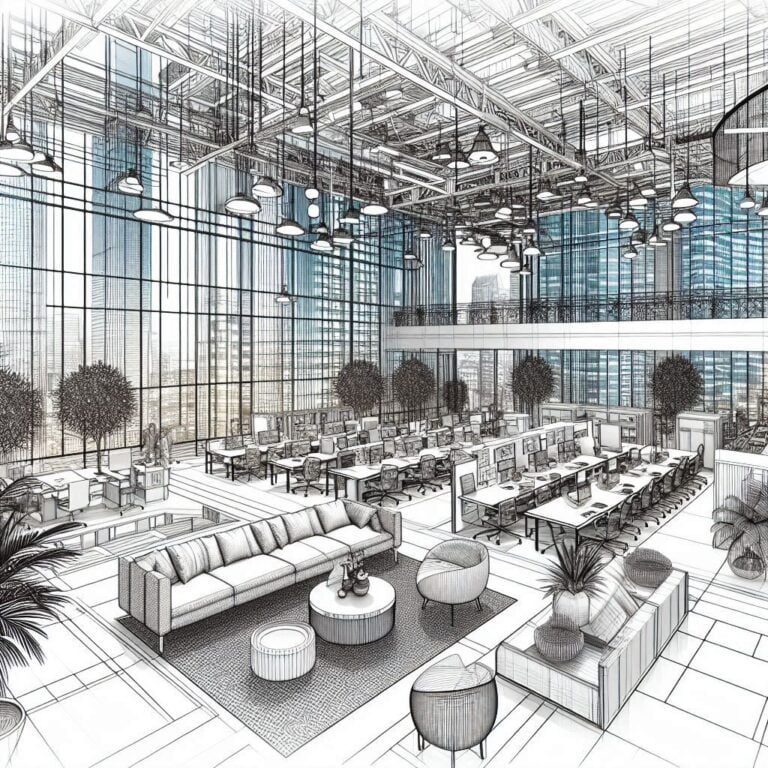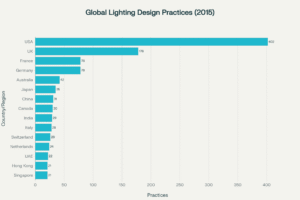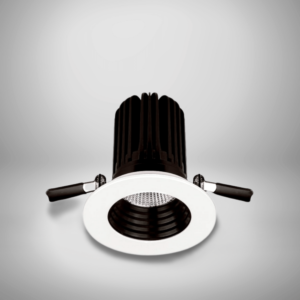Did you know that switching to energy-efficient LEDs can cut your carbon dioxide emissions by up to 35kg in Great Britain and 50kg in Northern Ireland annually? This fact highlights the significant role eco-conscious lighting solutions play in reducing environmental impact and saving money. This guide will delve into how sustainable lighting can transform your building, reduce energy costs, and lessen your ecological footprint.
Lighting uses 11% of the average UK household’s electricity, making it crucial for efficiency. By adopting technologies like LEDs, we can slash energy use by 70-80% over traditional bulbs. This not only extends the life of lighting fixtures by nearly a decade but also leads to substantial savings.
Environmentally friendly lighting fixtures also enhance the look and feel of your building. By choosing the right luminaire, lumen output, beam angle and colour temperature, we can create spaces that are bright and welcoming. This is crucial for businesses, homeowners, and facility managers alike, as the right lighting significantly improves the overall experience and appeal of your property.
Environmental and Financial Benefits of Green Lighting Solutions
Choosing sustainable led lights is a smart move for the planet and your finances. Switching to energy-efficient LED lights can cut carbon dioxide emissions by up to 35kg annually in Great Britain. This not only benefits the environment but also leads to lower energy bills, as lighting uses 11% of the average UK household’s electricity.
Lower Your Carbon Footprint
LED lights use up to 75% less energy than older lighting types, making them a pivotal choice for those seeking energy-saving lighting. Their longer lifespan means fewer replacements, reducing waste and the demand on resources. Additionally, LEDs produce minimal heat, which reduces cooling needs indoors, further highlighting their energy efficient lighting benefits.
Reduce Your Lighting Bills
Switching to energy-efficient lighting solutions also offers significant financial perks. The UK government provides incentives and rebates for businesses adopting energy-efficient lighting, offsetting the initial costs. This is particularly beneficial in retail, hospitality, manufacturing, and office settings, leading to long-term cost savings and increased efficiency.
Create a Bright and Inviting Space
Moreover, sustainable lighting technologies enhance the ambiance of spaces. LED lights offer superior illumination, ensuring clear visibility and safety. Their colour rendering index closely matches natural sunlight, improving colour perception and creating a welcoming atmosphere. This can lead to a more productive and pleasant environment in public areas.
The Evolution of Lighting Technology
The lighting industry has seen a significant shift in recent years, moving from inefficient incandescent bulbs to more energy-efficient options. Incandescent bulbs, which convert just 5% of the electricity they use into visible light, are being replaced. This change is towards more sustainable alternatives.
From Inefficient Incandescent to Energy-Efficient LEDs
LEDs stand out for their efficiency, with a longer lifespan and lower maintenance needs than traditional lights. This reduces replacement and disposal rates. They help cut electricity costs and lessen light pollution, benefiting the environment. Sustainable LED lighting technology also aids in reducing CO2 emissions, improving energy balance, and conserving resources.
Phasing Out Inefficient Lighting Solutions
Switching to LED lights can lead to substantial cost savings due to lower electricity consumption. Various areas like car parks, airports, railway stations, hospitals, and office buildings benefit from energy-efficient LED lighting. This results in significant cost and energy savings. LEDs are particularly suited for street lighting due to their resilience in cold temperatures, aiding ecological development.
Upgrading outdated lighting in buildings with sustainable LED technology can reduce electricity costs and environmental impact. This change makes a real difference in resource conservation. The shift to LED technology in street lighting can lead to a yearly reduction of about 1,091 tonnes of CO2 emissions.
Urban areas and local authorities worldwide are increasingly adopting LEDs for street and public lighting to enhance energy efficiency. LEDs in street lighting result in lower maintenance costs due to their extended lifespan and superior luminaire specifications.
Choosing the Right Energy-efficient Lighting Solutions
When considering sustainable led lighting options, it’s important to look at a variety of factors such as the lumen output, beam angle, dimming protocol and colour temperature. LEDs stand out as the top choice for their energy efficiency and versatility. They fit well in many settings, including dimmable lights and spotlights. CFLs are also good, but LEDs beat them in efficiency.
Selecting the Appropriate Bulb Type
Incandescent bulbs last about 1,000-2,000 hours, whereas LEDs can last well beyond 50,000 hours. They also use less electricity, which could cut energy use by 75% when switching to LEDs.
Considering Lumen Output and Colour Temperature
Choosing the right brightness means looking at lumens, not watts. Energy-efficient bulbs need fewer watts to shine as brightly. The colour temperature of the bulb, from warm white to cool white, should match the mood you want and the activity.
| Bulb Type | Lifespan (hours) | Energy Savings | Maintenance Costs |
|---|---|---|---|
| Traditional Incandescent | 1,000 – 2,000 | – | High |
| LED | 50,000+ | Up to 75% | Low |
By opting for green lighting solutions, we can cut our carbon footprint. We also get a bright, welcoming space and save on lighting costs.
Strategies for Maximising Lighting Efficiency
At the core of eco-friendly lighting solutions is the aim to maximise efficiency. By employing a comprehensive approach, we can significantly reduce energy and costs while ensuring our spaces remain well-lit and aesthetically pleasing. Let’s delve into the essential strategies that facilitate this objective.
Simple Practices, Significant Savings
Often, the simplest strategies are the most effective in enhancing lighting efficiency. Developing the habit of switching off lights when leaving a room and using sensors or timers for outdoor lighting can lead to substantial energy and cost cuts. Furthermore, being attentive to the number of lights in use and ensuring regular cleaning of fixtures and shades can improve lighting effectiveness, thus reducing the need for excessive brightness.
Harnessing Technology for Optimisation
The advancement of lighting technology has opened up new avenues for optimising lighting. Energy-efficient lighting technologies, such as LEDs and CFLs, use significantly less energy than traditional incandescent bulbs. By thoughtfully integrating these technologies, we can achieve considerable energy savings and lower our electricity expenses.
Embracing Automation and Intelligent Controls
Integrating motion sensors, timers, and automated systems can significantly boost our lighting efficiency efforts. These smart controls diminish energy waste by automatically turning off lights in unoccupied areas, ensuring illumination is only activated when and where necessary. Moreover, optimising the use of natural light can drastically reduce our dependence on artificial lighting during daylight, leading to further energy savings.
By adopting these lighting efficiency strategies, we not only reduce our environmental impact but also enjoy the financial benefits of lower energy consumption. As we continue to evolve and innovate, the opportunities for enhancing lighting efficiency expand, setting the stage for a more sustainable and financially viable future.
| Lighting Efficiency Strategies | Potential Energy Savings |
|---|---|
| LED Lighting Upgrades | Up to 75% energy savings compared to incandescent bulbs |
| Occupancy Sensors and Timers | Up to 30% energy savings |
| Daylighting Strategies | Up to 40% reduction in lighting energy use |
| Lighting Retrofits (e.g., T8 CFL lamps and electronic ballasts) | Significant energy efficiency improvements |
Eco-Conscious Lighting Solutions for Sustainable Homes
At the core of sustainable home design is the adoption of eco-conscious lighting solutions. By focusing on energy efficiency, we can lessen our artificial lighting use. This includes superior insulation, strategic window placement, and advanced ventilation systems. Additionally, using renewable energy sources like solar photovoltaic panels allows us to generate clean electricity for our homes.
Designing for Energy Efficiency
Sustainable home design starts with energy efficiency. We can reduce artificial lighting needs by optimising window placement and ensuring superior insulation. Advanced ventilation systems help regulate indoor temperatures. These strategies create a living space that depends less on power-hungry lighting solutions.
Sustainable Materials and Construction Techniques
At the core of green lighting solutions is a dedication to sustainable building materials and innovative construction methods. Architects, engineers, and builders are increasingly adopting a greener approach. They choose reclaimed wood, recycled metals, and low-impact concrete alternatives. These choices focus on durability, longevity, and environmental responsibility.
These decisions help to reduce waste and lower the carbon footprint of construction. They also enhance the energy efficiency and long-term sustainability of the building. By using eco-friendly materials and innovative building techniques, lighting solutions can be seamlessly integrated. This creates a harmonious, sustainable environment for living or working.
Sustainable Building Materials
- Reclaimed wood – Salvaged from old buildings, reclaimed wood has a lower environmental impact than new timber, while offering unique character and charm.
- Recycled metal – Metals like aluminium and steel can be infinitely recycled without losing their properties, making them a sustainable choice for construction.
- Low-impact concrete – Alternatives such as Ashcrete and Ferrock utilise recycled materials and reduce the carbon footprint associated with traditional concrete production.
- Hempcrete – A renewable and carbon-sequestering building material made from the woody core of the hemp plant, hempcrete offers excellent insulation properties.
- Sheep wool insulation – A natural, biodegradable insulator with a thermal conductivity comparable to synthetic options, sheep wool helps maintain a comfortable indoor climate.
Sustainable Construction Techniques
- Modular and prefabricated construction methods reduce waste and optimise energy efficiency during the building process.
- The use of renewable energy sources, such as solar panels, can power sustainable led lighting options and contribute to the overall sustainability of the structure.
- Passive design strategies, including optimised window placements and natural ventilation, minimise the need for artificial lighting and HVAC systems.
- Water conservation measures, such as greywater recycling and rainwater harvesting, help reduce the environmental impact of the building.
By embracing sustainable building materials and construction techniques, we can create structures that not only incorporate energy-efficient lighting but also align with the principles of environmental stewardship and long-term sustainability.
Sustainable LED Lights: A Holistic Approach to Sustainability
For true sustainability in lighting, we must look at the whole picture. This means considering the building’s design, energy use, and the use of renewable energy. It’s not just about swapping old lights for new, energy-saving ones. It’s about working together to make sure every part of the building’s integrated sustainable lighting, holistic sustainability, and sustainable led lights work together. This reduces energy use and cuts down on environmental harm.
By focusing on energy-efficient lighting solutions, we can make spaces that are good for the planet and nice to be in. This approach includes many sustainable practices, such as:
- Using energy-efficient LED lights that use much less energy than old bulbs, leading to big energy savings.
- Choosing lighting products made from recycled materials to lessen our need for new resources and promote responsible use.
- Designing lights that last longer and can be recycled, cutting down on waste from frequent replacements.
- Adding renewable energy sources like solar power to lower the building’s environmental impact even more.
With a focus on eco-conscious lighting solutions, we can make spaces that are not just beautiful but also help the planet. This way, businesses and homeowners can make a big difference in their environmental impact. They get the comfort and efficiency they want too.
“The future of lighting is not just about energy efficiency; it’s about creating a harmony between the built environment, renewable energy, and our natural resources.”
As we aim for a greener future, using integrated sustainable lighting, holistic sustainability, and eco-conscious building design will be key. It will change how we think about lighting, leading to a more eco-friendly and efficient built environment.
| Metric | 2020 Baseline | 2025 Goal | 2030 Goal |
|---|---|---|---|
| Electricity Production | 226,000 kWh | Maintain 5 times more production than consumption, with 70% of subcontractors’ electricity production being fossil-free | Maintain 5 times more production than consumption, with 90% of subcontractors’ electricity production being fossil-free |
| Electricity Consumption | 46,000 kWh | – | – |
| Rechargeable Transport | 100% fossil fuel | 80% rechargeable | 100% rechargeable |
Conclusion
Eco-conscious lighting solutions are set to revolutionise building design and energy use. By adopting energy-efficient technologies like LEDs and solar power, we can craft spaces that are both aesthetically pleasing and environmentally sustainable. These solutions lead to notable reductions in energy bills and carbon emissions, while enhancing the brightness and sustainability of our living or working spaces.
Our journey towards a greener future hinges on the widespread adoption of these innovative lighting technologies. LED lights, for instance, consume 75% less energy and last 25 times longer than traditional bulbs. Solar-powered and smart lighting systems are also redefining outdoor and indoor lighting, respectively. They optimise energy use and set new standards for efficiency.
By choosing eco-conscious lighting, we not only cut down on carbon emissions and save costs but also reflect our dedication to sustainability. The use of recycled materials and sustainable resources in lighting fixtures is a step in the right direction. Low-voltage landscape lighting is another example of how we can make a positive impact. Each decision we make towards eco-conscious lighting brings us closer to a brighter, sustainable future for everyone.
FAQ
What are the key benefits of adopting eco-conscious lighting solutions?
Eco-conscious lighting solutions bring numerous advantages. They cut down on carbon emissions, lower energy bills, and make spaces brighter and more welcoming. By opting for energy-efficient LED lights, households can drastically reduce their carbon dioxide emissions and electricity use. This leads to significant savings.
How has lighting technology evolved towards more sustainable options?
The lighting industry has seen a significant shift towards sustainability. It has moved from inefficient incandescent bulbs to more efficient options like CFLs and LEDs. These modern lights are much more energy-efficient, last longer, and provide better light quality. This evolution is setting the stage for a greener future.
What factors should be considered when selecting eco-conscious lighting solutions?
When picking eco-friendly lighting, consider the bulb type, lumen output, and colour temperature needed for your space. LEDs are now the top choice for their energy efficiency and versatility. CFLs are also a good option. It’s important to focus on lumens over watts and choose the right colour temperature for the desired mood and task.
How can homeowners and businesses maximise the efficiency of eco-conscious lighting solutions?
To get the most out of eco-conscious lighting, adopt a comprehensive strategy. Simple actions like turning off lights when leaving a room, using sensors or timers for outdoor lights, and keeping fixtures clean can save a lot of energy and money.
How can eco-conscious lighting solutions be integrated into sustainable home design?
Integrating eco-conscious lighting is key to sustainable home design. By focusing on energy efficiency through better insulation, smart window placement, and ventilation, you can reduce artificial lighting needs. Adding renewable energy sources like solar panels lets homes generate their own clean electricity for lighting.
What role do solar-powered lighting solutions play in the shift towards eco-conscious lighting?
Solar-powered lighting is gaining traction due to the push for renewable energy. Solar panels on rooftops capture sunlight to power homes, including their lighting. This clean energy source cuts down on fossil fuel use, lowers energy bills, and reduces carbon emissions.
How do sustainable materials and construction techniques contribute to eco-conscious lighting solutions?
Sustainable materials and building methods are crucial for eco-friendly lighting. Architects and builders now favour materials like reclaimed wood, recycled metal, and eco-friendly concrete. These choices reduce waste, lower construction carbon emissions, and enhance the building’s energy efficiency and sustainability.
What is the holistic approach to achieving true sustainability in lighting solutions?
For true sustainability in lighting, a comprehensive strategy is needed. It involves the building’s design, energy efficiency, and renewable energy use. Architects, engineers, and builders must work together to ensure every part of the building minimises energy use and environmental impact.












